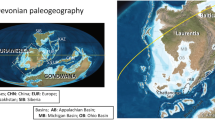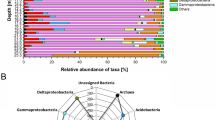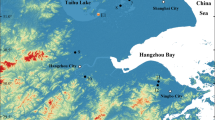Abstract
THIS paper reports new investigations carried out on the Teindland soil profile first described by E. A. FitzPatrick1. The section (grid ref. NJ 3297 8570) lies at an altitude of about 101 m OD in a disused quarry within Teindland Forest, 5 km south-west of Fochabers in Grampian Region, Scotland. The present study presents evidence which suggests that a fossil microflora contained within the soil can be assigned to two distinct phases of geological time, the Middle Devensian interstadial and the Ipswichian stage. This is augmented by stratigraphic analyses which suggest that the site is of wider significance for the Quaternary chronology of the area than has been appreciated.
This is a preview of subscription content, access via your institution
Access options
Subscribe to this journal
Receive 51 print issues and online access
$199.00 per year
only $3.90 per issue
Buy this article
- Purchase on Springer Link
- Instant access to full article PDF
Prices may be subject to local taxes which are calculated during checkout
Similar content being viewed by others
References
FitzPatrick, E. A., Nature, 207, 621–622 (1965).
Faegri, K., and Iversen, J., Textbook of Pollen Analysis (Munksgaard, Copenhagen, 1964).
American Commission on Stratigraphic Nomenclature, Bull. Am. Ass. Petrol. Geol., 45, 645–655 (1961).
Dimbleby, G. W., J. Soil Sci., 12, 1–11 (1961).
Havinga, A. J., Geologie Mijn., 53, 449–453 (1974).
Havinga, A. J., Pollen Spores, 6, 621–635 (1964).
Sparks, B. W., and West, R. G., Phil. Trans. R. Soc., B 258, 1–30 (1970).
Godwin, H., The History of the British Flora (Cambridge UniversityPress, 1975).
Phillips, L., Phil. Trans. R. Soc., B 275, 215–286 (1976).
Iversen, J., J. Ecol., 52 (suppl.), 59–70 (1964).
Havinga, A. J., Acta Bot. Neerl., 17, 1–4 (1968).
Florin, M. -B., Geol. For. Stockh. Förh., 97, 135–141 (1975).
Weymarn, J. von, and Edwards, K. J., Nature, 246, 473–474 (1973).
Birks, H. J. B., and Ransom, M. E., New Phytol., 68, 777–796 (1969).
Clapperton, C. M., and Sugden, D. E., in Quaternary Studies in North East Scotland (edit. by Gemmell, A. M. D.), 19–22 (Department of Geography, University of Aberdeen, 1975).
Romans, J. C. C., Stevens, J. H., and Robertson, L., J. Soil Sci., 17, 184–199 (1966).
Simpson, S., Trans. R. Soc. Edinb., 61, 687–698 (1948).
Clapperton, C. M., and Sudgen, D. E., in North East Scotland Geographical Essays (edit. by Clapperton, C. M.), 5–11 (Department of Geography, University of Aberdeen, 1972).
Author information
Authors and Affiliations
Rights and permissions
About this article
Cite this article
EDWARDS, K., CASELDINE, C. & CHESTER, D. Possible interstadial and interglacial pollen floras from Teindland, Scotland. Nature 264, 742–744 (1976). https://doi.org/10.1038/264742a0
Received:
Accepted:
Issue Date:
DOI: https://doi.org/10.1038/264742a0
This article is cited by
Comments
By submitting a comment you agree to abide by our Terms and Community Guidelines. If you find something abusive or that does not comply with our terms or guidelines please flag it as inappropriate.



